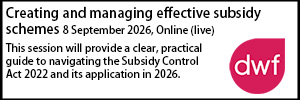Treasury told to be "rigorous" over guarantees for infrastructure projects
- Details
A spending watchdog has urged the Treasury to be “rigorous and objective” in assessing whether government guarantees for new UK infrastructure projects are genuinely needed.
The UK Guarantees scheme was introduced in 2012 because of adverse credit conditions for infrastructure projects.
Under the scheme the Treasury guarantees that lenders to such projects are repaid in full and on time, irrespective of the performance of the project. The Treasury receives a fee in return for the risk transfer.
To date the Treasury has guaranteed £1.7bn of finance across eight projects and ‘prequalified’ (deemed eligible for support) 39 more projects. The prequalified projects have a total value of £34bn.
Due to close in December 2016, the scheme is able to support up to £40bn in finance. The definition of infrastructure for the scheme is broad, and covers energy, transport, health, education, courts, prisons and housing.
The National Audit Office said in a report issued last week that market conditions had improved since the UK Guarantees scheme was launched.
The watchdog nevertheless suggested that the scheme could still play a role in enabling progress in some significant infrastructure projects.
The NAO report also concluded that:
- The Treasury had assembled an experienced commercial team and internal governance arrangements to measure and manage risks to the taxpayer.
- The length of exposure varied greatly depending on the project: “five years for an ethane import and storage facility at Grangemouth, up to 29 years in the case of the Mersey Gateway Bond and 44 years for the new University of Northampton campus.”
- The Scheme meant that the Treasury was in effect the second most active lender to new UK infrastructure projects in 2014.
- The Treasury did not apply its eligibility criteria strictly, since it had not put in place objective tests to check whether projects genuinely needed a guarantee. “For example, the Treasury supported one £8.8m project (to install energy saving lighting in 150 car parks) that is of a scale that cannot reasonably be described as meeting its ‘nationally significant’ test.”
The NAO noted that in providing guarantees, the Treasury did not consider the overall value for money of the projects, but used a narrow test that the guarantee fee must represent a market price for the risk. [To comply with state aid guidance, the scheme is not intended to provide subsidised loans for projects]
But the watchdog said it did not have full confidence “in the reliability or completeness of market benchmarks to measure actual risks to the taxpayer”.
Amyas Morse, head of the National Audit Office, said: “The Treasury takes a narrow view that guarantees are value for money if the fee covers the risk. It is good that Treasury has a formal governance process and commercial specialists to help evaluate, manage and set a price for risks to the taxpayer.
“However, we question whether this approach can measure long-term risks to taxpayers reliably. As market conditions improve, the Treasury should ensure that it is rigorous and objective in ensuring that guarantees for projects are genuinely needed and that the projects supported bring significant public value.”
Sponsored articles
Unlocking legal talent
Walker Morris supports Tower Hamlets Council in first known Remediation Contribution Order application issued by local authority
Contracts Lawyer
Legal Director - Government and Public Sector
Lawyer (Planning and Regulatory)
Locums
Poll
15-07-2026 11:00 am















































